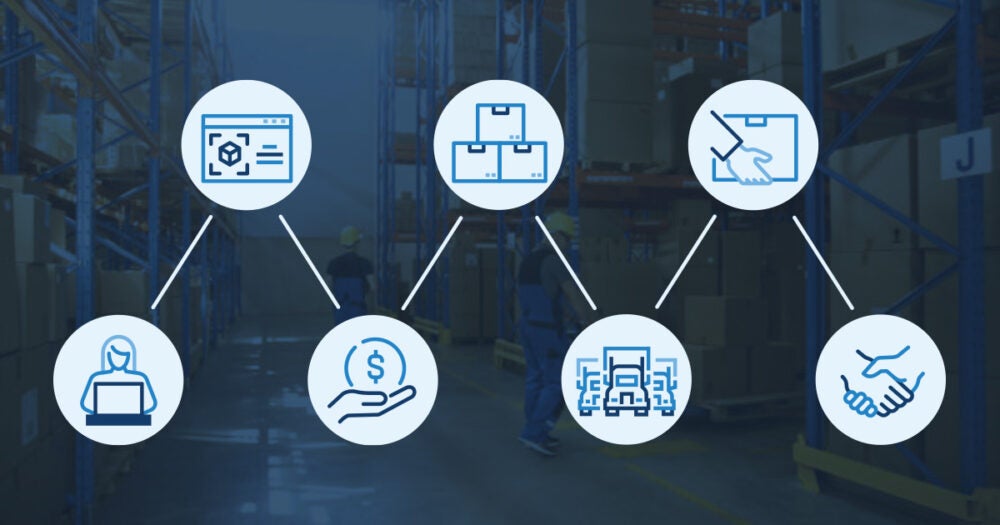Why do companies outsource logistics? It's simple: the modern supply chain is constantly evolving, and the standards used to regulate logistics management services are far more data- and technology-driven than those of the past. And as market volatility, delivery expectations and customer experiences impact supply chain strategies, shippers are looking for new ways to drive operational and competitive advantage from external expertise.
5 Signs That It's Time to Outsource Logistics
Recognizing the opportune time to outsource logistics can be crucial for business stability and growth. When weighing third-party logistics (3PL) transportation management vs. in-house logistics for your business, consider the following five signs that it may be time to add an outsourced managed logistics transportation services provider.
1. It's hard to track inventory from start to finish.
If you're having difficulty tracking your inventory from intake through the final mile, it may be time to consider switching from in-house logistics to logistics management services from a trusted 3PL. Poor visibility leads to additional delays in executing shipments, difficulty sharing updates with network partners and adverse impacts on customer experience. To have a fully optimized supply chain, you must have full visibility and inventory tracking over all your shipments from their first mile to their last. You'll also gain visibility from when you source materials through your shipments' white-glove delivery with a reliable 3PL transportation management system (TMS).
2. Freight spend keeps climbing.
Rising freight spend is a surefire indicator that it may be time to trust a 3PL with your logistics and transportation management. During times of high market volatility, freight spend will inevitably grow faster than anticipated. However, tendering shipments at higher rates in low volatility markets would suggest overspending, and for some shippers, those areas of excess spending may not necessarily be easy to identify. Gradually increasing freight spend that seems out of pace with the current expansion of your network and shipment volume is the defining indicator that it is time to consider outsourcing.
In a well set up managed logistics solution, a 3PL should serve as a strategic partner and ensure financial controls are in place across various levels, point of execution through financial forecasting, auditing and delivery.
3. Obtaining coverage is costing your workers too much time.
A top issue within a tightened capacity market is that it becomes difficult to get coverage for shipments. This is another great indicator that it may be time to outsource your logistics and transportation management. Depending on the typical workflows in your organization, spending too much time trying to get coverage for a load will lead to added back-office expenses.
For example, if it takes a team member 20 minutes to obtain coverage for a given shipment, that effectively limits the number of shipments covered for a week to 116. Now, let's assume that that team member makes an hourly wage of $20. That amounts to $800 in cost just for finding coverage across 116 shipments. Meanwhile, an automated tendering process within a TMS that could reduce the time needed down to mere minutes, such as five, would have the net effect of increasing the total volume of shipments tendered to 464 without necessarily increasing the back-office cost for that team member.
That's where automation within 3PL-driven systems can add value. A tech-enabled 3PL will be able to utilize and leverage modern software and streamline your processes, saving you both time and money. This allows for the exponential growth of profit margins by saving on back-office processes to execute more shipments and avoid delays.
4. You're missing opportunities or key details due to expanded responsibilities.
It's no secret that expanding responsibilities can lead to missed opportunities for oversight of partnerships and limited auditing of freight invoices. Depending on the source in question, most freight invoices contain some form of discrepancy.
Not all freight invoices are erroneous enough to the point where shippers are overbilled and underbilled. Discrepancies over time can impact overall performance ratings and adversely affect customer experiences. The worst-case scenario is excess freight spend for shipments that did not technically exist because they are duplicates. If your company is not actively auditing and filing claims against errors on invoices, you're leaving money on the table. To make the most of your efforts and ensure none of your hard-earned money is getting left behind, you'll likely want to partner with a trusted 3PL for logistics management services.
5. Your in-house logistics team struggles with strategic planning for freight management.
In-house logistics teams often tender more shipments in the spot market than with contracted carriers. In other words, your in-house team members are continuously putting shipments to the spot market and not taking advantage of the volume commitments and discounts associated with contracts. This may not necessarily be a problem, but it occurs as duties expand. Moreover, carriers may simply lack capacity or be experiencing other stressors. Rather than staying reactive and opening the door to significant risk and massive delays in overall shipment execution, it's best to let someone else handle the day-to-day of transportation through managed logistics.
Maximize Your Efforts with Managed Transportation Services from GlobalTranz
Day-to-day operations may seem in jeopardy when the business falls solely on in-house transportation services. Overwhelmed teams, time, and money can slip through the cracks if not managed appropriately. Managed logistics service from GlobalTranz will help businesses and customers to ship seamlessly and access the technology needed for growth. Whether you're shipping less-than-truckload (LTL) or full-truckload (FTL) freight, we have the solutions your business needs. Find out how your team could benefit from increased efficiency and value through managed logistics by connecting with a GlobalTranz expert now.

